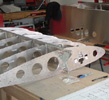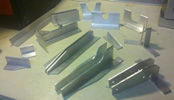


random user submitted photo
Differential Testing of Cylinders
15 posts
• Page 1 of 2 • 1, 2
Differential Testing of Cylinders
The cylinder leak down test is a pretty crude tool. Mechanics like Mike Busch have made a case for much of the data we get from EFIS type monitoring as being much more useful. None the less the Condition Inspection in the US requires a leakdown test via FAR Part 43 D
And when you get a "soft" cylinder - where is the problem? The valves in the head or the rings around the piston? Or both?
There are clues.
You can listen on the exhaust pipe for hissing - that usually means exhaust valve problems.
Hissing on the Crankcase breather - rings
Hissing in the induction manifold - inlet valves
But what if everything hisses and by how much?
-----
This simple jig made out of stout ply, some threaded rod and rubber mat will allow you to bolt the head down and test the valves. If you just reground valves - then after reassembly you can test to see that they really have seated properly. On this jig with the valves properly seated you should be able to achieve 80/80 on the valves.
Now with the head a known quantity - you can bolt it back to the cylinders and knowing the head is not leaking - you can pressurize the cylinders and find out how much you are losing through the rings.
--
An alternative on the cylinders only while the heads are off would be a piece of stout ply and rubber mat bolted onto the cylinder heads which would allow you to test the cylinders without using the head as a known quantity. Would need a solid insert to hold the pressure hose. I haven't made that up yet.
And when you get a "soft" cylinder - where is the problem? The valves in the head or the rings around the piston? Or both?
There are clues.
You can listen on the exhaust pipe for hissing - that usually means exhaust valve problems.
Hissing on the Crankcase breather - rings
Hissing in the induction manifold - inlet valves
But what if everything hisses and by how much?
-----
This simple jig made out of stout ply, some threaded rod and rubber mat will allow you to bolt the head down and test the valves. If you just reground valves - then after reassembly you can test to see that they really have seated properly. On this jig with the valves properly seated you should be able to achieve 80/80 on the valves.
Now with the head a known quantity - you can bolt it back to the cylinders and knowing the head is not leaking - you can pressurize the cylinders and find out how much you are losing through the rings.
--
An alternative on the cylinders only while the heads are off would be a piece of stout ply and rubber mat bolted onto the cylinder heads which would allow you to test the cylinders without using the head as a known quantity. Would need a solid insert to hold the pressure hose. I haven't made that up yet.
Graeme JW Smith
-

GraemeSmith - Posts: 939
- Joined: Sat May 18, 2019 8:58 am
- Location: RI
Re: Differential Testing of Cylinders
GraemeSmith wrote:The cylinder leak down test is a pretty crude tool. Mechanics like Mike Busch have made a case for much of the data we get from EFIS type monitoring as being much more useful. None the less the Condition Inspection in the US requires a leakdown test via FAR Part 43 D
I’d like to learn how FAR Part 43 D requires us to perform a leak down test on an experimental aircraft. It had always been my understanding that we are conducting a condition inspection, not an annual inspection.
Should we test compression? Yes. But I’m not sure it’s required per FAR Part 43 D.
Joe Norris - Does FAR Part 43 D *require* a compression test in an experimental condition inspection?
Robbie Culver
Sonex 1517
Aero Estates (T25)
First flight 10/10/2015
375+ hours
Jabiru 3300 Gen 4
Prince P Tip
Taildragger
N1517S
Sonex 1517
Aero Estates (T25)
First flight 10/10/2015
375+ hours
Jabiru 3300 Gen 4
Prince P Tip
Taildragger
N1517S
-

Sonex1517 - Posts: 1670
- Joined: Fri Jun 03, 2011 10:11 am
- Location: T25 Aero Estates, Frankston, TX
Re: Differential Testing of Cylinders
43D does require a compression test. It does NOT specify a specific method of performing the test.
Mel Asberry..DAR since last century
A&P/BGI/EAA (LifeTime) Tech Counselor/Flight Advisor/Nat'l Test Pilot School/Tony Bingelis Award/Wright Brothers Master Pilot Award..N168YX reserved
A&P/BGI/EAA (LifeTime) Tech Counselor/Flight Advisor/Nat'l Test Pilot School/Tony Bingelis Award/Wright Brothers Master Pilot Award..N168YX reserved
-

Mel - Posts: 15
- Joined: Fri Feb 14, 2020 5:52 pm
- Location: North Texas (Dallas Area)
Re: Differential Testing of Cylinders
GraemeSmith wrote:Robbie - 43 D (d) 3
I know. And that’s what I use. Question is - it says annual and 100 hour. We do not do annuals.
I’m genuinely curious as this is a somewhat gray area to me.
Robbie Culver
Sonex 1517
Aero Estates (T25)
First flight 10/10/2015
375+ hours
Jabiru 3300 Gen 4
Prince P Tip
Taildragger
N1517S
Sonex 1517
Aero Estates (T25)
First flight 10/10/2015
375+ hours
Jabiru 3300 Gen 4
Prince P Tip
Taildragger
N1517S
-

Sonex1517 - Posts: 1670
- Joined: Fri Jun 03, 2011 10:11 am
- Location: T25 Aero Estates, Frankston, TX
Re: Differential Testing of Cylinders
Mel wrote:43D does require a compression test. It does NOT specify a specific method of performing the test.
Thanks Mel!
Does our condition inspection legally fall into the same FAR?
Robbie Culver
Sonex 1517
Aero Estates (T25)
First flight 10/10/2015
375+ hours
Jabiru 3300 Gen 4
Prince P Tip
Taildragger
N1517S
Sonex 1517
Aero Estates (T25)
First flight 10/10/2015
375+ hours
Jabiru 3300 Gen 4
Prince P Tip
Taildragger
N1517S
-

Sonex1517 - Posts: 1670
- Joined: Fri Jun 03, 2011 10:11 am
- Location: T25 Aero Estates, Frankston, TX
Re: Differential Testing of Cylinders
Sonex1517 wrote:Mel wrote:43D does require a compression test. It does NOT specify a specific method of performing the test.
Thanks Mel!
Does our condition inspection legally fall into the same FAR?
Yes, your operating limitations should state that to operate the aircraft, a condition inspection must have been completed within the previous 12 calendar months. This inspection will be conducted in accordance with the scope & detail of part 43 appendix D.
Our experimental amateur-built aircraft must be operated IAW the operating limitations issued to that aircraft and FAR part 91.
Mel Asberry..DAR since last century
A&P/BGI/EAA (LifeTime) Tech Counselor/Flight Advisor/Nat'l Test Pilot School/Tony Bingelis Award/Wright Brothers Master Pilot Award..N168YX reserved
A&P/BGI/EAA (LifeTime) Tech Counselor/Flight Advisor/Nat'l Test Pilot School/Tony Bingelis Award/Wright Brothers Master Pilot Award..N168YX reserved
-

Mel - Posts: 15
- Joined: Fri Feb 14, 2020 5:52 pm
- Location: North Texas (Dallas Area)
Re: Differential Testing of Cylinders
Mel wrote:43D does require a compression test. It does NOT specify a specific method of performing the test.
The other method I'm aware of is to put a pressure gauge directly into a spark plug hole and crank the engine with the mags off and see what the highest sustained reading is. But the answer is usually somewhat transient as the pressure is being provided by the cranking and quickly falls off if there are problems. Leaving you little time to listen at inlet, exhaust and crankcase to try and figure where the issue is.
Any other method? Like Robbie - genuinely curious...
Graeme JW Smith
-

GraemeSmith - Posts: 939
- Joined: Sat May 18, 2019 8:58 am
- Location: RI
Re: Differential Testing of Cylinders
GraemeSmith wrote:Mel wrote:43D does require a compression test. It does NOT specify a specific method of performing the test.
The other method I'm aware of is to put a pressure gauge directly into a spark plug hole and crank the engine with the mags off and see what the highest sustained reading is. But the answer is usually somewhat transient as the pressure is being provided by the cranking and quickly falls off if there are problems. Leaving you little time to listen at inlet, exhaust and crankcase to try and figure where the issue is.
Any other method? Like Robbie - genuinely curious...
These are the only 2 practical methods that I'm aware of. The method you describe tells the overall condition of the cylinder, but the leak down method is the only way I know of that allows further trouble shooting. OTOH, the leak down method does not tell you the condition of the cylinder below TDC.
Mel Asberry..DAR since last century
A&P/BGI/EAA (LifeTime) Tech Counselor/Flight Advisor/Nat'l Test Pilot School/Tony Bingelis Award/Wright Brothers Master Pilot Award..N168YX reserved
A&P/BGI/EAA (LifeTime) Tech Counselor/Flight Advisor/Nat'l Test Pilot School/Tony Bingelis Award/Wright Brothers Master Pilot Award..N168YX reserved
-

Mel - Posts: 15
- Joined: Fri Feb 14, 2020 5:52 pm
- Location: North Texas (Dallas Area)
Re: Differential Testing of Cylinders
Mel wrote:GraemeSmith wrote:Mel wrote:43D does require a compression test. It does NOT specify a specific method of performing the test.
The other method I'm aware of is to put a pressure gauge directly into a spark plug hole and crank the engine with the mags off and see what the highest sustained reading is. But the answer is usually somewhat transient as the pressure is being provided by the cranking and quickly falls off if there are problems. Leaving you little time to listen at inlet, exhaust and crankcase to try and figure where the issue is.
Any other method? Like Robbie - genuinely curious...
These are the only 2 practical methods that I'm aware of. The method you describe tells the overall condition of the cylinder, but the leak down method is the only way I know of that allows further trouble shooting. OTOH, the leak down method does not tell you the condition of the cylinder below TDC.
It's pretty common in certified engines to have a little taper in the cylinders to tighten the rings up at the top. Below that it doesn't matter.
OneX 107
N2107X
N2107X
- Onex107
- Posts: 506
- Joined: Mon Mar 24, 2014 6:44 pm
- Location: Peoria, IL
15 posts
• Page 1 of 2 • 1, 2
Who is online
Users browsing this forum: No registered users and 63 guests







